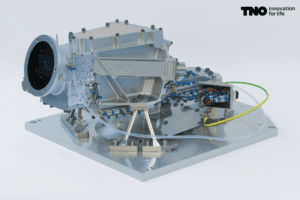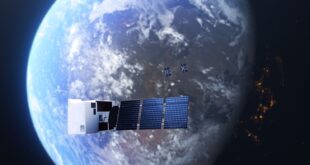
TNO is the first to deliver an optical module to German Airbus Defence & Space which is assembling the Sentinel-5 satellite instrument. The aim of Sentinel-5 is to accurately monitor the composition of the Earth’s atmosphere on a daily basis. In developing a spectrometer and a telescope for the satellite, TNO is making a major contribution to the mapping of air pollution and greenhouse gases.
Sentinel-5 Mission
Sentinel-5 is part of the European Copernicus program that is being coordinated by the European Commission to monitor the Earth’s atmosphere. The space component of the Copernicus program is being developed and contracted by the European Space Agency (ESA). The Sentinel-5 mission focuses on air quality and its interaction with the climate. The satellite will map nitrogen oxides and methane, among others.
Multiple, identical satellites are being built to be launched into space one after the other. This will ensure decades of continuous, reliable data on how the atmosphere and climate changes are developing. The first satellite is expected to be launched in 2022.
UV1 & TSBOA
Several European companies are developing components for the Sentinel-5 instruments. “Airbus in Germany is going to assemble the satellites. We are developing two important subsystems: a spectrometer (UV1) for a certain wavelength spectrum (270-300 nm) and two telescopes (TSBOA),” says Wim Gielesen. “We are the first party to supply Airbus with a key optical module. And additional measures have enabled TNO today to succeed in delivering the spectrometer (UV1) that is so crucial for this mission with little delay, despite the corona crisis,” says Gielesen.
With over 50 years of experience TNO has a proven track record in building space instruments and components for ESA and NASA missions. Dozens of satellites are equipped with optical systems designed, built and tested by TNO. The most recent example is TROPOMI, the satellite instrument on board the Sentinel-5 Precursor satellite (S5P), launched at the end of 2017. TROPOMI provides daily global measurements with a unique high spatial resolution of 7 × 3.5 km.
Compact, light, but robust
The requirements for the telescope and spectrometer are very strict. “We develop parts that are as compact and light as possible yet, at the same time, robust enough to survive a launch, which involves forces of 22 times that of gravity and enormous temperature differences (-20 to 60° Celsius). We work on the edge of what is achievable. This is possible thanks to our unique knowledge in the field of freeform optics and mechanics.
What is unique about the mirrors in these components is that they are polished to an enormously smooth extent, to less than a nanometer. You could compare it to smoothing out the surface of the whole of the Netherlands to a difference in height of a few millimetres. The fact that the mirrors are so smooth means that there is less disruption from stray light, which makes the image pure,” explains Gielesen.
Intensive Cooperation
TNO has a lot of interaction with Airbus and also with Dutch and European suppliers. “The cooperation is going well. Of course, there are technical challenges, but everyone is very closely involved, critical and collaborates with us. It’s nice to see that Airbus is happy with our state-of-the-art instruments,” says Gielesen.
Combating air pollution & climate change
On the basis of TROPOMI, and later Sentinel-5, policymakers and industry will have access to useful information on the monitoring and reduction of air pollution. Also, the Satellite can help measure global concentrations and very large hotspots of methane, a major greenhouse gas.
The resolution of Sentinel-5 will be comparable to that of TROPOMI, but because we can measure closer to the edges of clouds, we can more accurately map locations that are more difficult to reach. By adding an extra wavelength range (an extra channel) more gases can also be measured. Because TROPOMI and Sentinel-5 have different orbits and collect data at a different time (9.30 and 14.00), the combination of both satellites also provides important information about the daily passage of substances in the atmosphere.
“We are developing instruments to combat air pollution and climate change and to stimulate economic growth,” explains Kees Buijsrogge, Director of Space & Scientific Instrumentation. “Air pollution is a very topical subject that is high on the political agenda. Sentinel 5 will provide global and independent measurements of this every day. TROPOMI shows that there has been a sharp fall in nitrogen emissions during the corona crisis. Now that many countries are opening up again, emissions will start to rise again. We are proud that TNO makes an important contribution to the instrument on Sentinel 5 that will keep monitoring issues like this in the decades ahead so that policymakers can take informed actions,” says Buijsrogge.
For more information visit here.





